Principles of Public Health: Ethical Allocation of Scarce Resources
VerifiedAdded on 2021/06/17
|11
|3120
|116
Essay
AI Summary
This essay delves into the principles of public health, specifically addressing the challenge of resource scarcity within the Australian healthcare system. It examines the reasons behind this scarcity, including budgetary constraints and high demand, and explores ethical principles for resource allocation. The essay highlights the importance of equal treatment, prioritizing the worst-off, and utilitarianism in decision-making. It then presents a framework for priority setting, encompassing data comparison, consideration of social determinants of health, identifying the scale of the problem, aligning with government priorities, assessing financial costs, potential for improvement, and the strength of the evidence base. The discussion emphasizes the need for a structured approach to ensure fair and equitable distribution of limited resources, ultimately aiming to improve health outcomes for the population. The essay stresses the importance of considering both evidentiary, moral, social, economic, and political factors when allocating scarce resources.
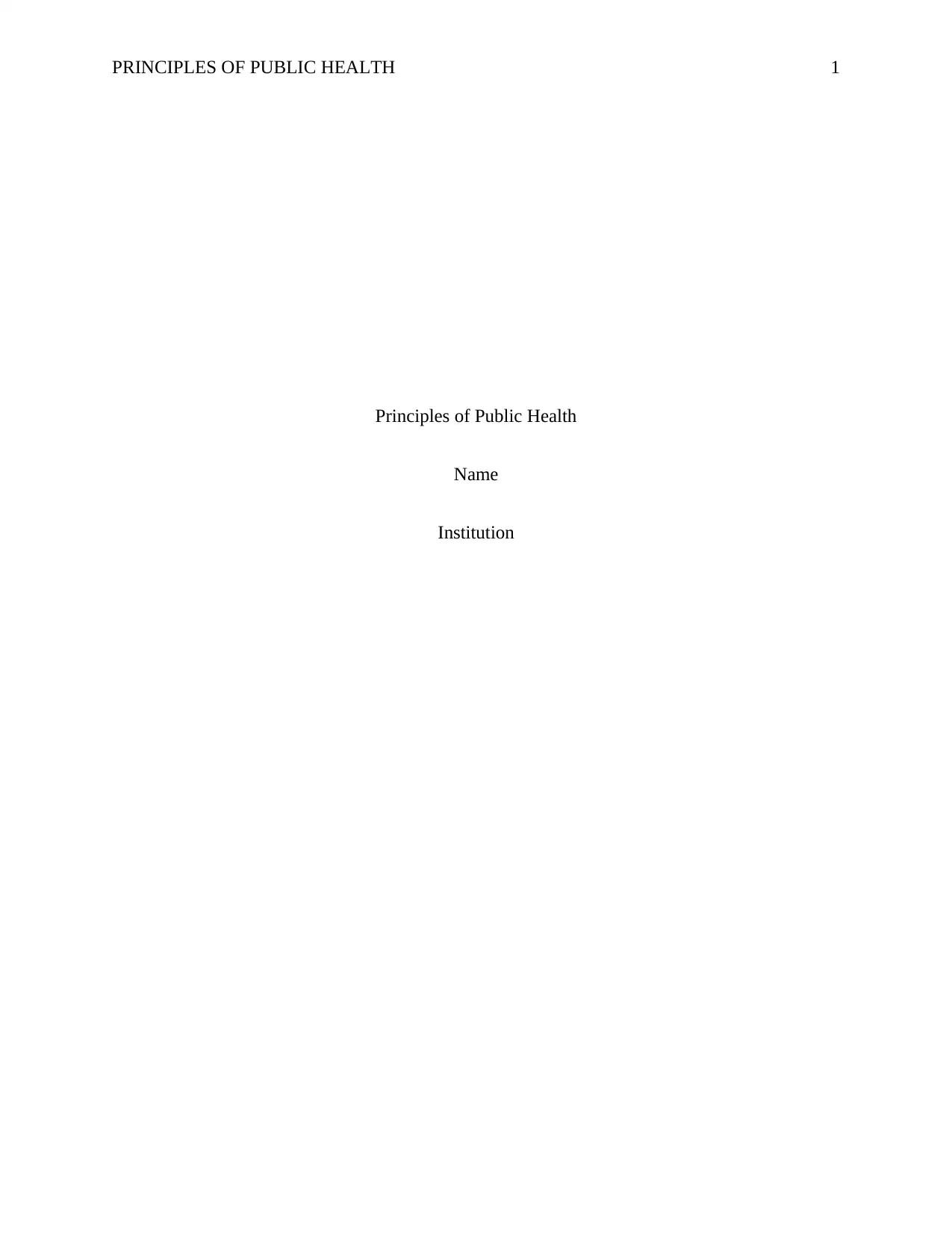
PRINCIPLES OF PUBLIC HEALTH 1
Principles of Public Health
Name
Institution
Principles of Public Health
Name
Institution
Paraphrase This Document
Need a fresh take? Get an instant paraphrase of this document with our AI Paraphraser
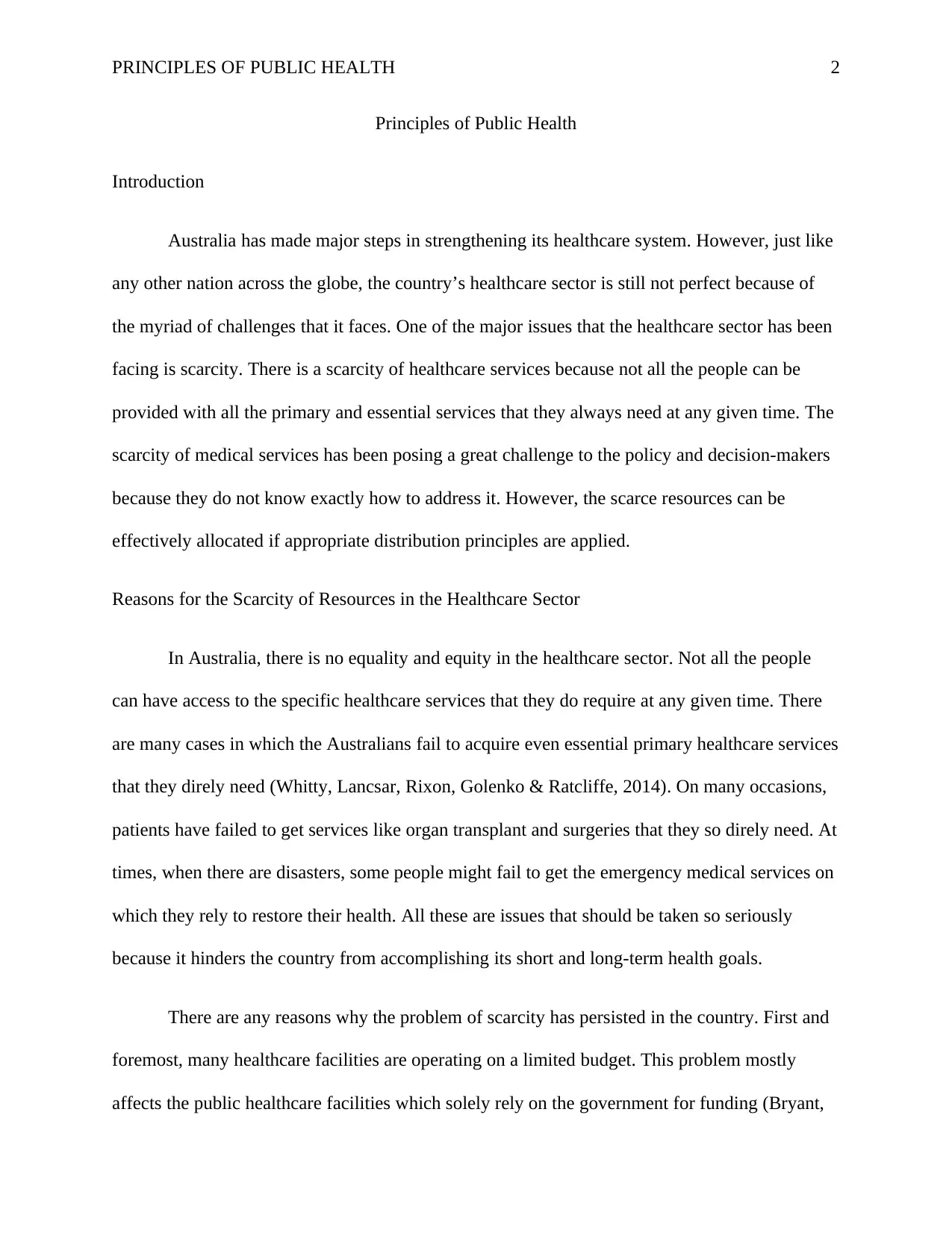
PRINCIPLES OF PUBLIC HEALTH 2
Principles of Public Health
Introduction
Australia has made major steps in strengthening its healthcare system. However, just like
any other nation across the globe, the country’s healthcare sector is still not perfect because of
the myriad of challenges that it faces. One of the major issues that the healthcare sector has been
facing is scarcity. There is a scarcity of healthcare services because not all the people can be
provided with all the primary and essential services that they always need at any given time. The
scarcity of medical services has been posing a great challenge to the policy and decision-makers
because they do not know exactly how to address it. However, the scarce resources can be
effectively allocated if appropriate distribution principles are applied.
Reasons for the Scarcity of Resources in the Healthcare Sector
In Australia, there is no equality and equity in the healthcare sector. Not all the people
can have access to the specific healthcare services that they do require at any given time. There
are many cases in which the Australians fail to acquire even essential primary healthcare services
that they direly need (Whitty, Lancsar, Rixon, Golenko & Ratcliffe, 2014). On many occasions,
patients have failed to get services like organ transplant and surgeries that they so direly need. At
times, when there are disasters, some people might fail to get the emergency medical services on
which they rely to restore their health. All these are issues that should be taken so seriously
because it hinders the country from accomplishing its short and long-term health goals.
There are any reasons why the problem of scarcity has persisted in the country. First and
foremost, many healthcare facilities are operating on a limited budget. This problem mostly
affects the public healthcare facilities which solely rely on the government for funding (Bryant,
Principles of Public Health
Introduction
Australia has made major steps in strengthening its healthcare system. However, just like
any other nation across the globe, the country’s healthcare sector is still not perfect because of
the myriad of challenges that it faces. One of the major issues that the healthcare sector has been
facing is scarcity. There is a scarcity of healthcare services because not all the people can be
provided with all the primary and essential services that they always need at any given time. The
scarcity of medical services has been posing a great challenge to the policy and decision-makers
because they do not know exactly how to address it. However, the scarce resources can be
effectively allocated if appropriate distribution principles are applied.
Reasons for the Scarcity of Resources in the Healthcare Sector
In Australia, there is no equality and equity in the healthcare sector. Not all the people
can have access to the specific healthcare services that they do require at any given time. There
are many cases in which the Australians fail to acquire even essential primary healthcare services
that they direly need (Whitty, Lancsar, Rixon, Golenko & Ratcliffe, 2014). On many occasions,
patients have failed to get services like organ transplant and surgeries that they so direly need. At
times, when there are disasters, some people might fail to get the emergency medical services on
which they rely to restore their health. All these are issues that should be taken so seriously
because it hinders the country from accomplishing its short and long-term health goals.
There are any reasons why the problem of scarcity has persisted in the country. First and
foremost, many healthcare facilities are operating on a limited budget. This problem mostly
affects the public healthcare facilities which solely rely on the government for funding (Bryant,
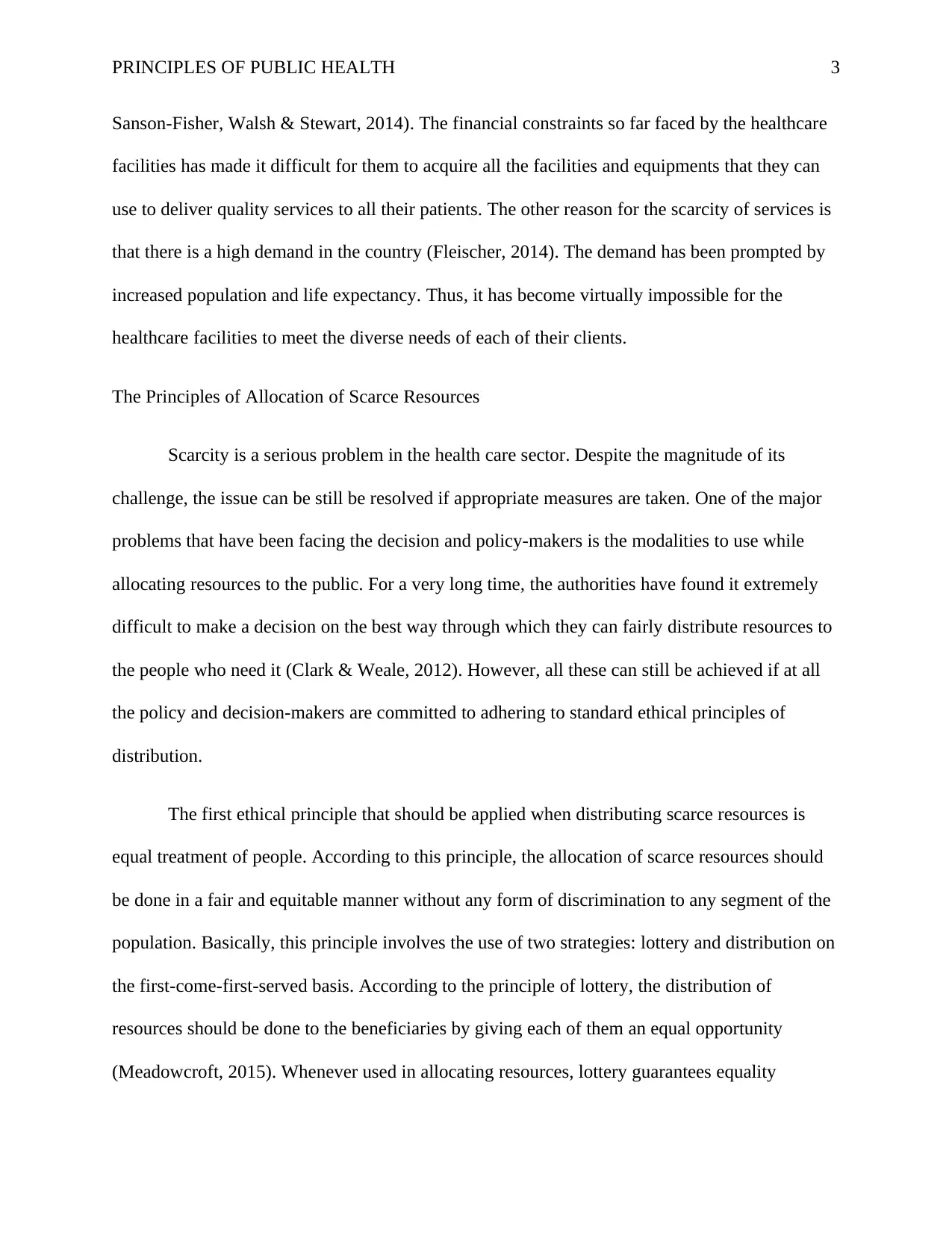
PRINCIPLES OF PUBLIC HEALTH 3
Sanson-Fisher, Walsh & Stewart, 2014). The financial constraints so far faced by the healthcare
facilities has made it difficult for them to acquire all the facilities and equipments that they can
use to deliver quality services to all their patients. The other reason for the scarcity of services is
that there is a high demand in the country (Fleischer, 2014). The demand has been prompted by
increased population and life expectancy. Thus, it has become virtually impossible for the
healthcare facilities to meet the diverse needs of each of their clients.
The Principles of Allocation of Scarce Resources
Scarcity is a serious problem in the health care sector. Despite the magnitude of its
challenge, the issue can be still be resolved if appropriate measures are taken. One of the major
problems that have been facing the decision and policy-makers is the modalities to use while
allocating resources to the public. For a very long time, the authorities have found it extremely
difficult to make a decision on the best way through which they can fairly distribute resources to
the people who need it (Clark & Weale, 2012). However, all these can still be achieved if at all
the policy and decision-makers are committed to adhering to standard ethical principles of
distribution.
The first ethical principle that should be applied when distributing scarce resources is
equal treatment of people. According to this principle, the allocation of scarce resources should
be done in a fair and equitable manner without any form of discrimination to any segment of the
population. Basically, this principle involves the use of two strategies: lottery and distribution on
the first-come-first-served basis. According to the principle of lottery, the distribution of
resources should be done to the beneficiaries by giving each of them an equal opportunity
(Meadowcroft, 2015). Whenever used in allocating resources, lottery guarantees equality
Sanson-Fisher, Walsh & Stewart, 2014). The financial constraints so far faced by the healthcare
facilities has made it difficult for them to acquire all the facilities and equipments that they can
use to deliver quality services to all their patients. The other reason for the scarcity of services is
that there is a high demand in the country (Fleischer, 2014). The demand has been prompted by
increased population and life expectancy. Thus, it has become virtually impossible for the
healthcare facilities to meet the diverse needs of each of their clients.
The Principles of Allocation of Scarce Resources
Scarcity is a serious problem in the health care sector. Despite the magnitude of its
challenge, the issue can be still be resolved if appropriate measures are taken. One of the major
problems that have been facing the decision and policy-makers is the modalities to use while
allocating resources to the public. For a very long time, the authorities have found it extremely
difficult to make a decision on the best way through which they can fairly distribute resources to
the people who need it (Clark & Weale, 2012). However, all these can still be achieved if at all
the policy and decision-makers are committed to adhering to standard ethical principles of
distribution.
The first ethical principle that should be applied when distributing scarce resources is
equal treatment of people. According to this principle, the allocation of scarce resources should
be done in a fair and equitable manner without any form of discrimination to any segment of the
population. Basically, this principle involves the use of two strategies: lottery and distribution on
the first-come-first-served basis. According to the principle of lottery, the distribution of
resources should be done to the beneficiaries by giving each of them an equal opportunity
(Meadowcroft, 2015). Whenever used in allocating resources, lottery guarantees equality
⊘ This is a preview!⊘
Do you want full access?
Subscribe today to unlock all pages.

Trusted by 1+ million students worldwide
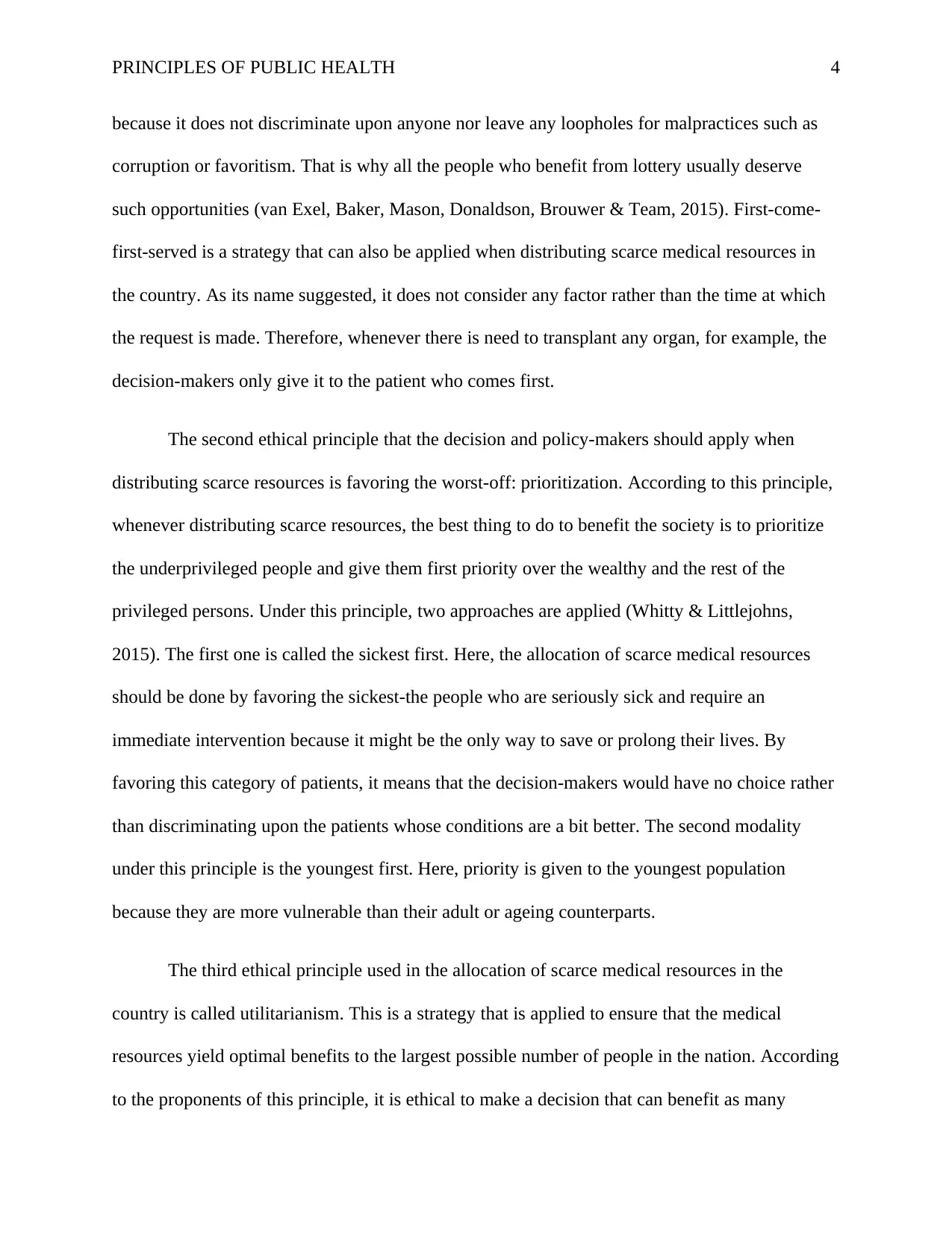
PRINCIPLES OF PUBLIC HEALTH 4
because it does not discriminate upon anyone nor leave any loopholes for malpractices such as
corruption or favoritism. That is why all the people who benefit from lottery usually deserve
such opportunities (van Exel, Baker, Mason, Donaldson, Brouwer & Team, 2015). First-come-
first-served is a strategy that can also be applied when distributing scarce medical resources in
the country. As its name suggested, it does not consider any factor rather than the time at which
the request is made. Therefore, whenever there is need to transplant any organ, for example, the
decision-makers only give it to the patient who comes first.
The second ethical principle that the decision and policy-makers should apply when
distributing scarce resources is favoring the worst-off: prioritization. According to this principle,
whenever distributing scarce resources, the best thing to do to benefit the society is to prioritize
the underprivileged people and give them first priority over the wealthy and the rest of the
privileged persons. Under this principle, two approaches are applied (Whitty & Littlejohns,
2015). The first one is called the sickest first. Here, the allocation of scarce medical resources
should be done by favoring the sickest-the people who are seriously sick and require an
immediate intervention because it might be the only way to save or prolong their lives. By
favoring this category of patients, it means that the decision-makers would have no choice rather
than discriminating upon the patients whose conditions are a bit better. The second modality
under this principle is the youngest first. Here, priority is given to the youngest population
because they are more vulnerable than their adult or ageing counterparts.
The third ethical principle used in the allocation of scarce medical resources in the
country is called utilitarianism. This is a strategy that is applied to ensure that the medical
resources yield optimal benefits to the largest possible number of people in the nation. According
to the proponents of this principle, it is ethical to make a decision that can benefit as many
because it does not discriminate upon anyone nor leave any loopholes for malpractices such as
corruption or favoritism. That is why all the people who benefit from lottery usually deserve
such opportunities (van Exel, Baker, Mason, Donaldson, Brouwer & Team, 2015). First-come-
first-served is a strategy that can also be applied when distributing scarce medical resources in
the country. As its name suggested, it does not consider any factor rather than the time at which
the request is made. Therefore, whenever there is need to transplant any organ, for example, the
decision-makers only give it to the patient who comes first.
The second ethical principle that the decision and policy-makers should apply when
distributing scarce resources is favoring the worst-off: prioritization. According to this principle,
whenever distributing scarce resources, the best thing to do to benefit the society is to prioritize
the underprivileged people and give them first priority over the wealthy and the rest of the
privileged persons. Under this principle, two approaches are applied (Whitty & Littlejohns,
2015). The first one is called the sickest first. Here, the allocation of scarce medical resources
should be done by favoring the sickest-the people who are seriously sick and require an
immediate intervention because it might be the only way to save or prolong their lives. By
favoring this category of patients, it means that the decision-makers would have no choice rather
than discriminating upon the patients whose conditions are a bit better. The second modality
under this principle is the youngest first. Here, priority is given to the youngest population
because they are more vulnerable than their adult or ageing counterparts.
The third ethical principle used in the allocation of scarce medical resources in the
country is called utilitarianism. This is a strategy that is applied to ensure that the medical
resources yield optimal benefits to the largest possible number of people in the nation. According
to the proponents of this principle, it is ethical to make a decision that can benefit as many
Paraphrase This Document
Need a fresh take? Get an instant paraphrase of this document with our AI Paraphraser
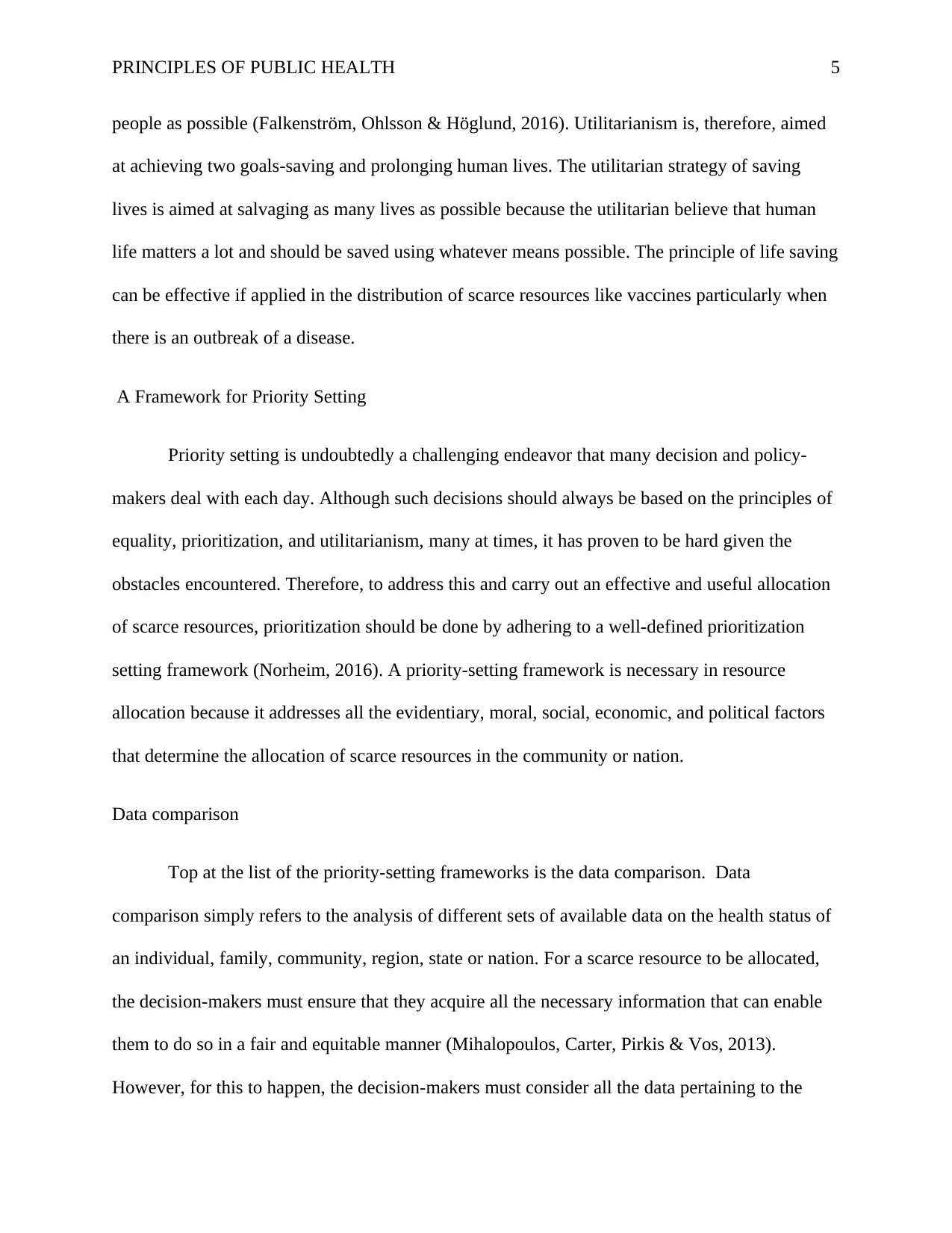
PRINCIPLES OF PUBLIC HEALTH 5
people as possible (Falkenström, Ohlsson & Höglund, 2016). Utilitarianism is, therefore, aimed
at achieving two goals-saving and prolonging human lives. The utilitarian strategy of saving
lives is aimed at salvaging as many lives as possible because the utilitarian believe that human
life matters a lot and should be saved using whatever means possible. The principle of life saving
can be effective if applied in the distribution of scarce resources like vaccines particularly when
there is an outbreak of a disease.
A Framework for Priority Setting
Priority setting is undoubtedly a challenging endeavor that many decision and policy-
makers deal with each day. Although such decisions should always be based on the principles of
equality, prioritization, and utilitarianism, many at times, it has proven to be hard given the
obstacles encountered. Therefore, to address this and carry out an effective and useful allocation
of scarce resources, prioritization should be done by adhering to a well-defined prioritization
setting framework (Norheim, 2016). A priority-setting framework is necessary in resource
allocation because it addresses all the evidentiary, moral, social, economic, and political factors
that determine the allocation of scarce resources in the community or nation.
Data comparison
Top at the list of the priority-setting frameworks is the data comparison. Data
comparison simply refers to the analysis of different sets of available data on the health status of
an individual, family, community, region, state or nation. For a scarce resource to be allocated,
the decision-makers must ensure that they acquire all the necessary information that can enable
them to do so in a fair and equitable manner (Mihalopoulos, Carter, Pirkis & Vos, 2013).
However, for this to happen, the decision-makers must consider all the data pertaining to the
people as possible (Falkenström, Ohlsson & Höglund, 2016). Utilitarianism is, therefore, aimed
at achieving two goals-saving and prolonging human lives. The utilitarian strategy of saving
lives is aimed at salvaging as many lives as possible because the utilitarian believe that human
life matters a lot and should be saved using whatever means possible. The principle of life saving
can be effective if applied in the distribution of scarce resources like vaccines particularly when
there is an outbreak of a disease.
A Framework for Priority Setting
Priority setting is undoubtedly a challenging endeavor that many decision and policy-
makers deal with each day. Although such decisions should always be based on the principles of
equality, prioritization, and utilitarianism, many at times, it has proven to be hard given the
obstacles encountered. Therefore, to address this and carry out an effective and useful allocation
of scarce resources, prioritization should be done by adhering to a well-defined prioritization
setting framework (Norheim, 2016). A priority-setting framework is necessary in resource
allocation because it addresses all the evidentiary, moral, social, economic, and political factors
that determine the allocation of scarce resources in the community or nation.
Data comparison
Top at the list of the priority-setting frameworks is the data comparison. Data
comparison simply refers to the analysis of different sets of available data on the health status of
an individual, family, community, region, state or nation. For a scarce resource to be allocated,
the decision-makers must ensure that they acquire all the necessary information that can enable
them to do so in a fair and equitable manner (Mihalopoulos, Carter, Pirkis & Vos, 2013).
However, for this to happen, the decision-makers must consider all the data pertaining to the
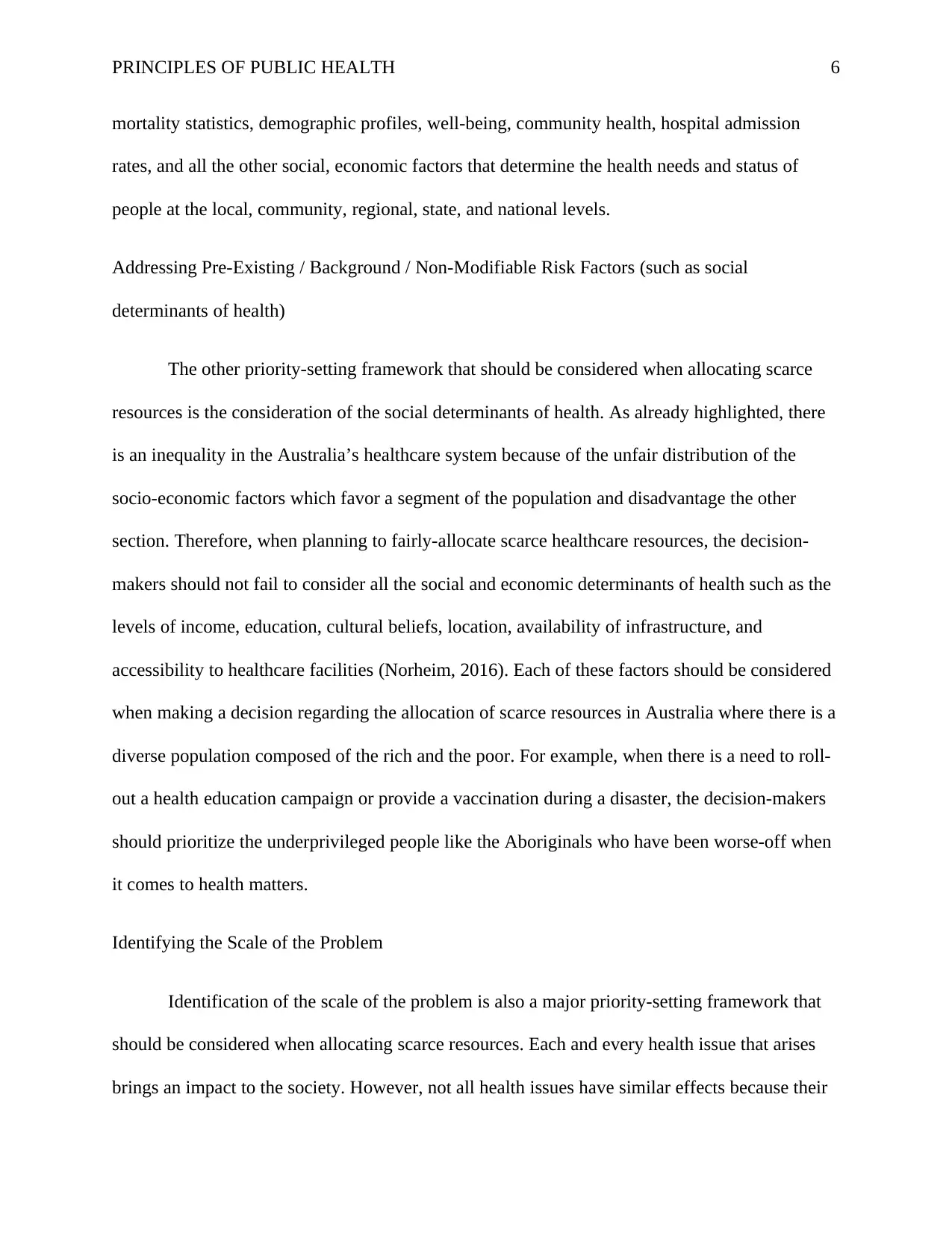
PRINCIPLES OF PUBLIC HEALTH 6
mortality statistics, demographic profiles, well-being, community health, hospital admission
rates, and all the other social, economic factors that determine the health needs and status of
people at the local, community, regional, state, and national levels.
Addressing Pre-Existing / Background / Non-Modifiable Risk Factors (such as social
determinants of health)
The other priority-setting framework that should be considered when allocating scarce
resources is the consideration of the social determinants of health. As already highlighted, there
is an inequality in the Australia’s healthcare system because of the unfair distribution of the
socio-economic factors which favor a segment of the population and disadvantage the other
section. Therefore, when planning to fairly-allocate scarce healthcare resources, the decision-
makers should not fail to consider all the social and economic determinants of health such as the
levels of income, education, cultural beliefs, location, availability of infrastructure, and
accessibility to healthcare facilities (Norheim, 2016). Each of these factors should be considered
when making a decision regarding the allocation of scarce resources in Australia where there is a
diverse population composed of the rich and the poor. For example, when there is a need to roll-
out a health education campaign or provide a vaccination during a disaster, the decision-makers
should prioritize the underprivileged people like the Aboriginals who have been worse-off when
it comes to health matters.
Identifying the Scale of the Problem
Identification of the scale of the problem is also a major priority-setting framework that
should be considered when allocating scarce resources. Each and every health issue that arises
brings an impact to the society. However, not all health issues have similar effects because their
mortality statistics, demographic profiles, well-being, community health, hospital admission
rates, and all the other social, economic factors that determine the health needs and status of
people at the local, community, regional, state, and national levels.
Addressing Pre-Existing / Background / Non-Modifiable Risk Factors (such as social
determinants of health)
The other priority-setting framework that should be considered when allocating scarce
resources is the consideration of the social determinants of health. As already highlighted, there
is an inequality in the Australia’s healthcare system because of the unfair distribution of the
socio-economic factors which favor a segment of the population and disadvantage the other
section. Therefore, when planning to fairly-allocate scarce healthcare resources, the decision-
makers should not fail to consider all the social and economic determinants of health such as the
levels of income, education, cultural beliefs, location, availability of infrastructure, and
accessibility to healthcare facilities (Norheim, 2016). Each of these factors should be considered
when making a decision regarding the allocation of scarce resources in Australia where there is a
diverse population composed of the rich and the poor. For example, when there is a need to roll-
out a health education campaign or provide a vaccination during a disaster, the decision-makers
should prioritize the underprivileged people like the Aboriginals who have been worse-off when
it comes to health matters.
Identifying the Scale of the Problem
Identification of the scale of the problem is also a major priority-setting framework that
should be considered when allocating scarce resources. Each and every health issue that arises
brings an impact to the society. However, not all health issues have similar effects because their
⊘ This is a preview!⊘
Do you want full access?
Subscribe today to unlock all pages.

Trusted by 1+ million students worldwide
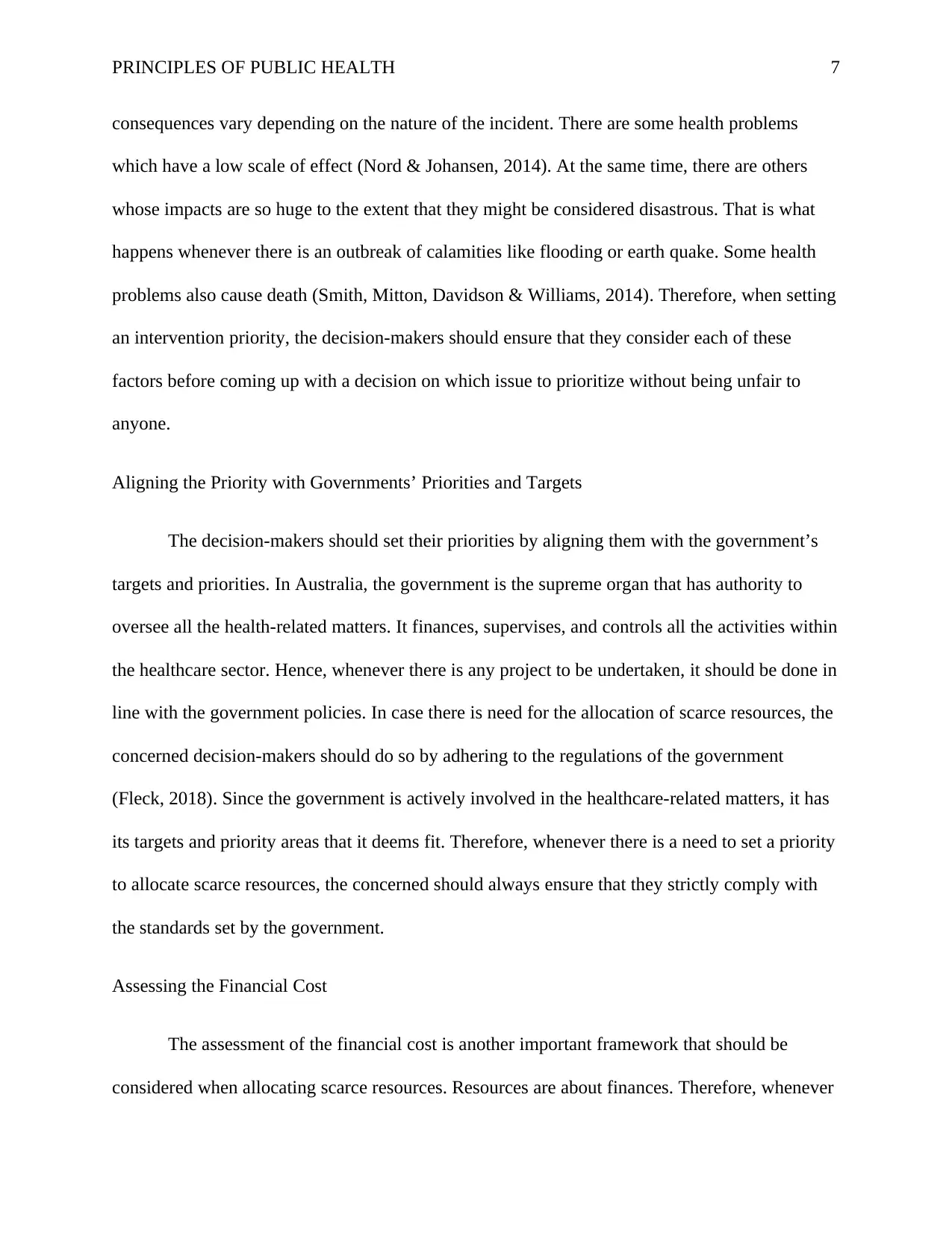
PRINCIPLES OF PUBLIC HEALTH 7
consequences vary depending on the nature of the incident. There are some health problems
which have a low scale of effect (Nord & Johansen, 2014). At the same time, there are others
whose impacts are so huge to the extent that they might be considered disastrous. That is what
happens whenever there is an outbreak of calamities like flooding or earth quake. Some health
problems also cause death (Smith, Mitton, Davidson & Williams, 2014). Therefore, when setting
an intervention priority, the decision-makers should ensure that they consider each of these
factors before coming up with a decision on which issue to prioritize without being unfair to
anyone.
Aligning the Priority with Governments’ Priorities and Targets
The decision-makers should set their priorities by aligning them with the government’s
targets and priorities. In Australia, the government is the supreme organ that has authority to
oversee all the health-related matters. It finances, supervises, and controls all the activities within
the healthcare sector. Hence, whenever there is any project to be undertaken, it should be done in
line with the government policies. In case there is need for the allocation of scarce resources, the
concerned decision-makers should do so by adhering to the regulations of the government
(Fleck, 2018). Since the government is actively involved in the healthcare-related matters, it has
its targets and priority areas that it deems fit. Therefore, whenever there is a need to set a priority
to allocate scarce resources, the concerned should always ensure that they strictly comply with
the standards set by the government.
Assessing the Financial Cost
The assessment of the financial cost is another important framework that should be
considered when allocating scarce resources. Resources are about finances. Therefore, whenever
consequences vary depending on the nature of the incident. There are some health problems
which have a low scale of effect (Nord & Johansen, 2014). At the same time, there are others
whose impacts are so huge to the extent that they might be considered disastrous. That is what
happens whenever there is an outbreak of calamities like flooding or earth quake. Some health
problems also cause death (Smith, Mitton, Davidson & Williams, 2014). Therefore, when setting
an intervention priority, the decision-makers should ensure that they consider each of these
factors before coming up with a decision on which issue to prioritize without being unfair to
anyone.
Aligning the Priority with Governments’ Priorities and Targets
The decision-makers should set their priorities by aligning them with the government’s
targets and priorities. In Australia, the government is the supreme organ that has authority to
oversee all the health-related matters. It finances, supervises, and controls all the activities within
the healthcare sector. Hence, whenever there is any project to be undertaken, it should be done in
line with the government policies. In case there is need for the allocation of scarce resources, the
concerned decision-makers should do so by adhering to the regulations of the government
(Fleck, 2018). Since the government is actively involved in the healthcare-related matters, it has
its targets and priority areas that it deems fit. Therefore, whenever there is a need to set a priority
to allocate scarce resources, the concerned should always ensure that they strictly comply with
the standards set by the government.
Assessing the Financial Cost
The assessment of the financial cost is another important framework that should be
considered when allocating scarce resources. Resources are about finances. Therefore, whenever
Paraphrase This Document
Need a fresh take? Get an instant paraphrase of this document with our AI Paraphraser
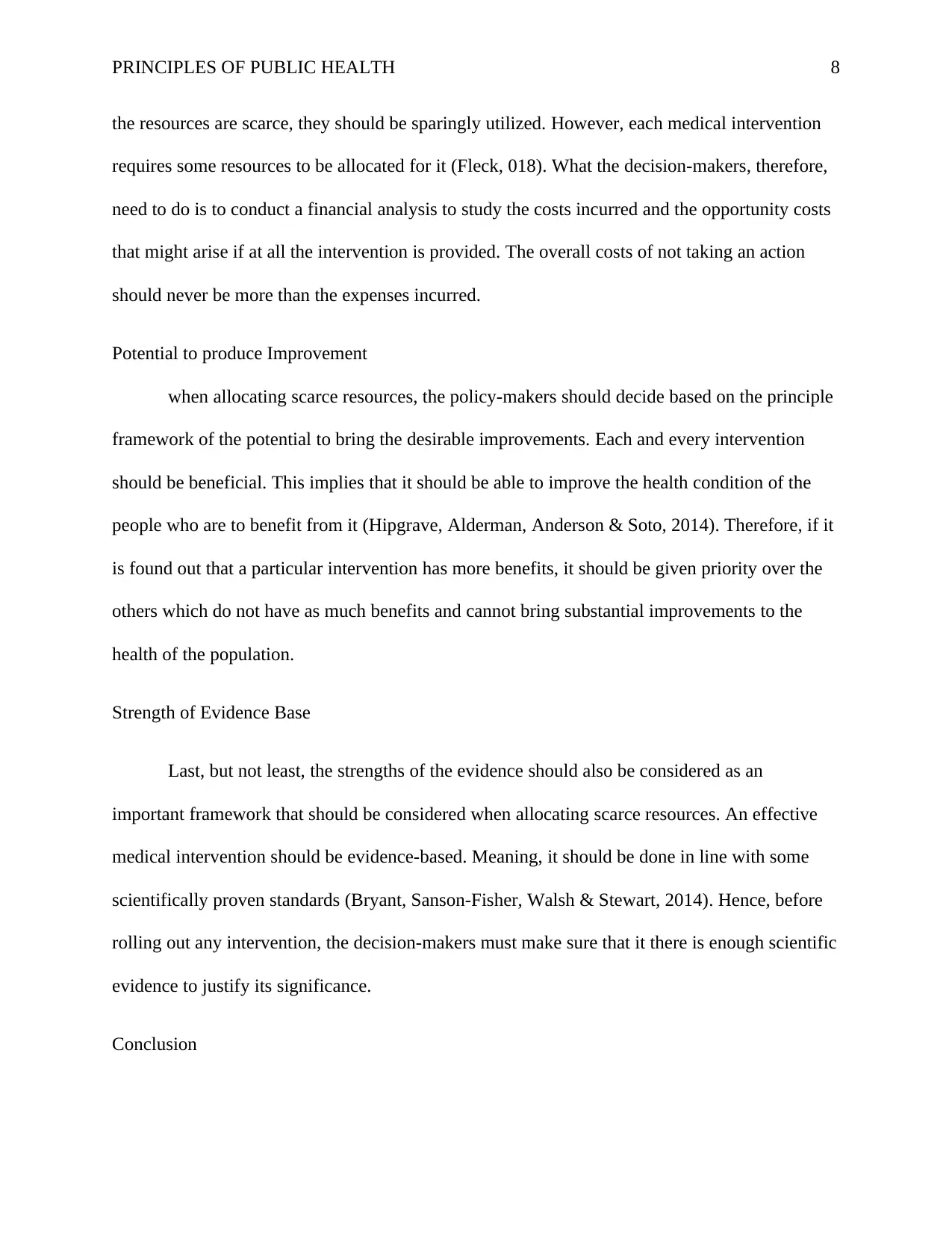
PRINCIPLES OF PUBLIC HEALTH 8
the resources are scarce, they should be sparingly utilized. However, each medical intervention
requires some resources to be allocated for it (Fleck, 018). What the decision-makers, therefore,
need to do is to conduct a financial analysis to study the costs incurred and the opportunity costs
that might arise if at all the intervention is provided. The overall costs of not taking an action
should never be more than the expenses incurred.
Potential to produce Improvement
when allocating scarce resources, the policy-makers should decide based on the principle
framework of the potential to bring the desirable improvements. Each and every intervention
should be beneficial. This implies that it should be able to improve the health condition of the
people who are to benefit from it (Hipgrave, Alderman, Anderson & Soto, 2014). Therefore, if it
is found out that a particular intervention has more benefits, it should be given priority over the
others which do not have as much benefits and cannot bring substantial improvements to the
health of the population.
Strength of Evidence Base
Last, but not least, the strengths of the evidence should also be considered as an
important framework that should be considered when allocating scarce resources. An effective
medical intervention should be evidence-based. Meaning, it should be done in line with some
scientifically proven standards (Bryant, Sanson-Fisher, Walsh & Stewart, 2014). Hence, before
rolling out any intervention, the decision-makers must make sure that it there is enough scientific
evidence to justify its significance.
Conclusion
the resources are scarce, they should be sparingly utilized. However, each medical intervention
requires some resources to be allocated for it (Fleck, 018). What the decision-makers, therefore,
need to do is to conduct a financial analysis to study the costs incurred and the opportunity costs
that might arise if at all the intervention is provided. The overall costs of not taking an action
should never be more than the expenses incurred.
Potential to produce Improvement
when allocating scarce resources, the policy-makers should decide based on the principle
framework of the potential to bring the desirable improvements. Each and every intervention
should be beneficial. This implies that it should be able to improve the health condition of the
people who are to benefit from it (Hipgrave, Alderman, Anderson & Soto, 2014). Therefore, if it
is found out that a particular intervention has more benefits, it should be given priority over the
others which do not have as much benefits and cannot bring substantial improvements to the
health of the population.
Strength of Evidence Base
Last, but not least, the strengths of the evidence should also be considered as an
important framework that should be considered when allocating scarce resources. An effective
medical intervention should be evidence-based. Meaning, it should be done in line with some
scientifically proven standards (Bryant, Sanson-Fisher, Walsh & Stewart, 2014). Hence, before
rolling out any intervention, the decision-makers must make sure that it there is enough scientific
evidence to justify its significance.
Conclusion
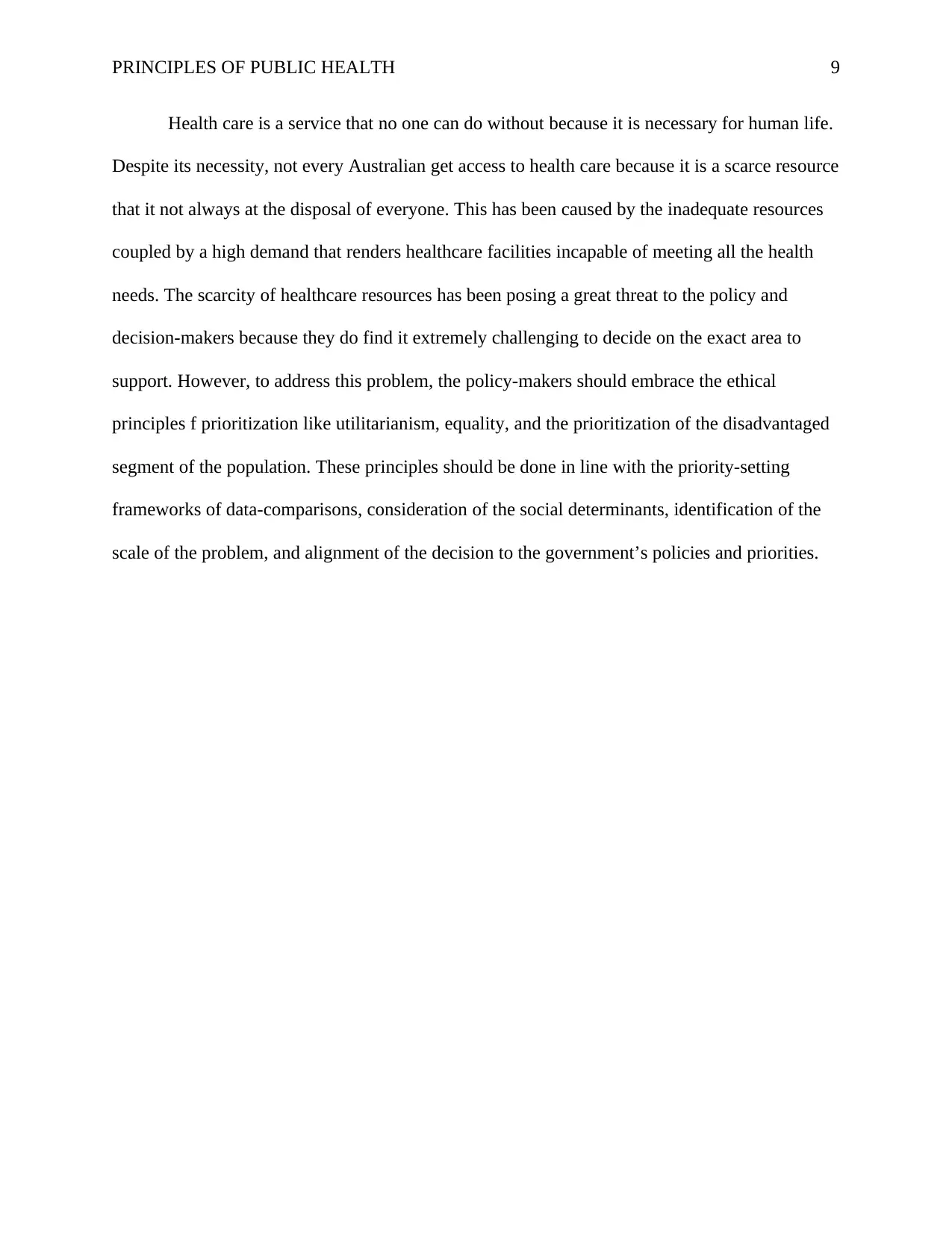
PRINCIPLES OF PUBLIC HEALTH 9
Health care is a service that no one can do without because it is necessary for human life.
Despite its necessity, not every Australian get access to health care because it is a scarce resource
that it not always at the disposal of everyone. This has been caused by the inadequate resources
coupled by a high demand that renders healthcare facilities incapable of meeting all the health
needs. The scarcity of healthcare resources has been posing a great threat to the policy and
decision-makers because they do find it extremely challenging to decide on the exact area to
support. However, to address this problem, the policy-makers should embrace the ethical
principles f prioritization like utilitarianism, equality, and the prioritization of the disadvantaged
segment of the population. These principles should be done in line with the priority-setting
frameworks of data-comparisons, consideration of the social determinants, identification of the
scale of the problem, and alignment of the decision to the government’s policies and priorities.
Health care is a service that no one can do without because it is necessary for human life.
Despite its necessity, not every Australian get access to health care because it is a scarce resource
that it not always at the disposal of everyone. This has been caused by the inadequate resources
coupled by a high demand that renders healthcare facilities incapable of meeting all the health
needs. The scarcity of healthcare resources has been posing a great threat to the policy and
decision-makers because they do find it extremely challenging to decide on the exact area to
support. However, to address this problem, the policy-makers should embrace the ethical
principles f prioritization like utilitarianism, equality, and the prioritization of the disadvantaged
segment of the population. These principles should be done in line with the priority-setting
frameworks of data-comparisons, consideration of the social determinants, identification of the
scale of the problem, and alignment of the decision to the government’s policies and priorities.
⊘ This is a preview!⊘
Do you want full access?
Subscribe today to unlock all pages.

Trusted by 1+ million students worldwide
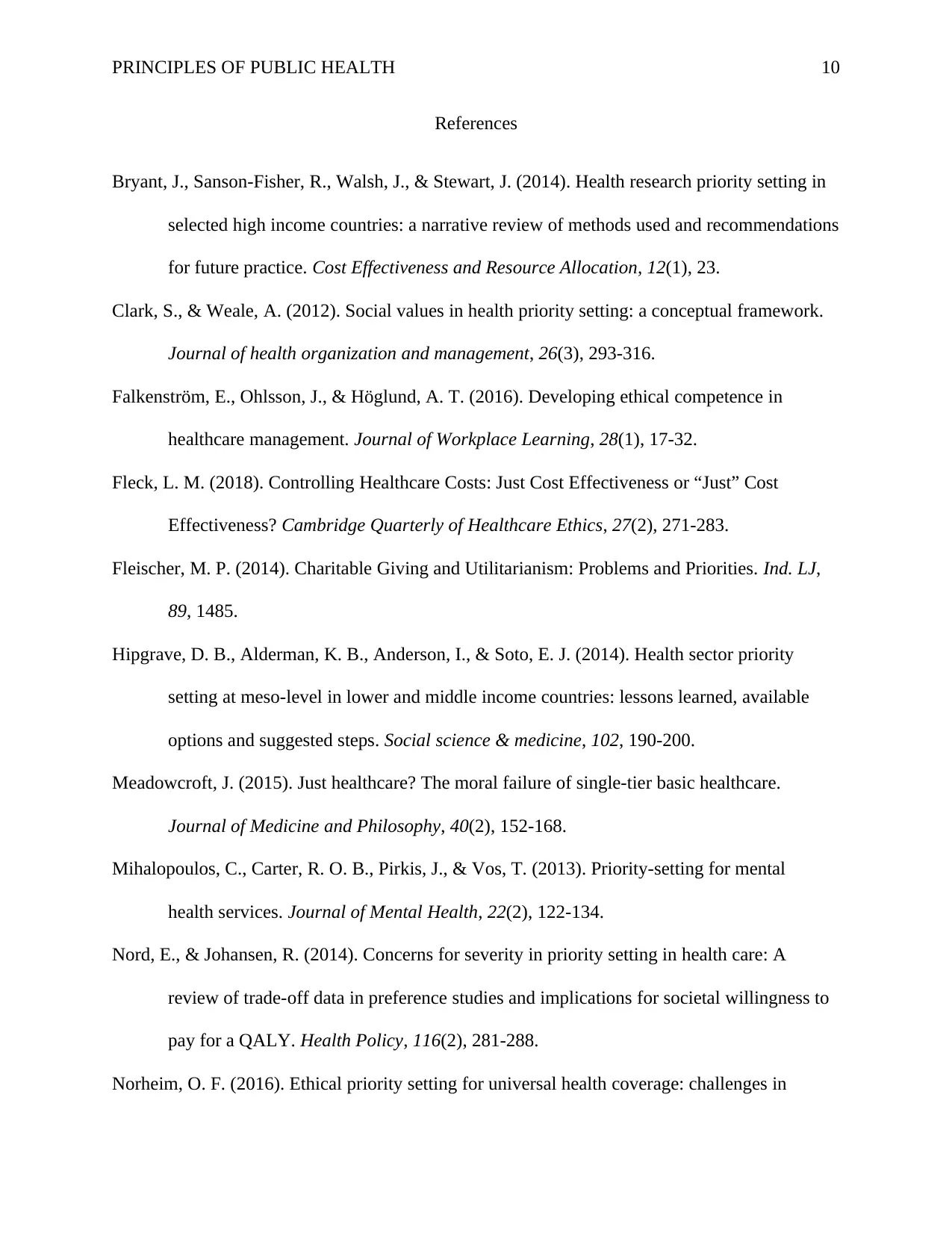
PRINCIPLES OF PUBLIC HEALTH 10
References
Bryant, J., Sanson-Fisher, R., Walsh, J., & Stewart, J. (2014). Health research priority setting in
selected high income countries: a narrative review of methods used and recommendations
for future practice. Cost Effectiveness and Resource Allocation, 12(1), 23.
Clark, S., & Weale, A. (2012). Social values in health priority setting: a conceptual framework.
Journal of health organization and management, 26(3), 293-316.
Falkenström, E., Ohlsson, J., & Höglund, A. T. (2016). Developing ethical competence in
healthcare management. Journal of Workplace Learning, 28(1), 17-32.
Fleck, L. M. (2018). Controlling Healthcare Costs: Just Cost Effectiveness or “Just” Cost
Effectiveness? Cambridge Quarterly of Healthcare Ethics, 27(2), 271-283.
Fleischer, M. P. (2014). Charitable Giving and Utilitarianism: Problems and Priorities. Ind. LJ,
89, 1485.
Hipgrave, D. B., Alderman, K. B., Anderson, I., & Soto, E. J. (2014). Health sector priority
setting at meso-level in lower and middle income countries: lessons learned, available
options and suggested steps. Social science & medicine, 102, 190-200.
Meadowcroft, J. (2015). Just healthcare? The moral failure of single-tier basic healthcare.
Journal of Medicine and Philosophy, 40(2), 152-168.
Mihalopoulos, C., Carter, R. O. B., Pirkis, J., & Vos, T. (2013). Priority-setting for mental
health services. Journal of Mental Health, 22(2), 122-134.
Nord, E., & Johansen, R. (2014). Concerns for severity in priority setting in health care: A
review of trade-off data in preference studies and implications for societal willingness to
pay for a QALY. Health Policy, 116(2), 281-288.
Norheim, O. F. (2016). Ethical priority setting for universal health coverage: challenges in
References
Bryant, J., Sanson-Fisher, R., Walsh, J., & Stewart, J. (2014). Health research priority setting in
selected high income countries: a narrative review of methods used and recommendations
for future practice. Cost Effectiveness and Resource Allocation, 12(1), 23.
Clark, S., & Weale, A. (2012). Social values in health priority setting: a conceptual framework.
Journal of health organization and management, 26(3), 293-316.
Falkenström, E., Ohlsson, J., & Höglund, A. T. (2016). Developing ethical competence in
healthcare management. Journal of Workplace Learning, 28(1), 17-32.
Fleck, L. M. (2018). Controlling Healthcare Costs: Just Cost Effectiveness or “Just” Cost
Effectiveness? Cambridge Quarterly of Healthcare Ethics, 27(2), 271-283.
Fleischer, M. P. (2014). Charitable Giving and Utilitarianism: Problems and Priorities. Ind. LJ,
89, 1485.
Hipgrave, D. B., Alderman, K. B., Anderson, I., & Soto, E. J. (2014). Health sector priority
setting at meso-level in lower and middle income countries: lessons learned, available
options and suggested steps. Social science & medicine, 102, 190-200.
Meadowcroft, J. (2015). Just healthcare? The moral failure of single-tier basic healthcare.
Journal of Medicine and Philosophy, 40(2), 152-168.
Mihalopoulos, C., Carter, R. O. B., Pirkis, J., & Vos, T. (2013). Priority-setting for mental
health services. Journal of Mental Health, 22(2), 122-134.
Nord, E., & Johansen, R. (2014). Concerns for severity in priority setting in health care: A
review of trade-off data in preference studies and implications for societal willingness to
pay for a QALY. Health Policy, 116(2), 281-288.
Norheim, O. F. (2016). Ethical priority setting for universal health coverage: challenges in
Paraphrase This Document
Need a fresh take? Get an instant paraphrase of this document with our AI Paraphraser
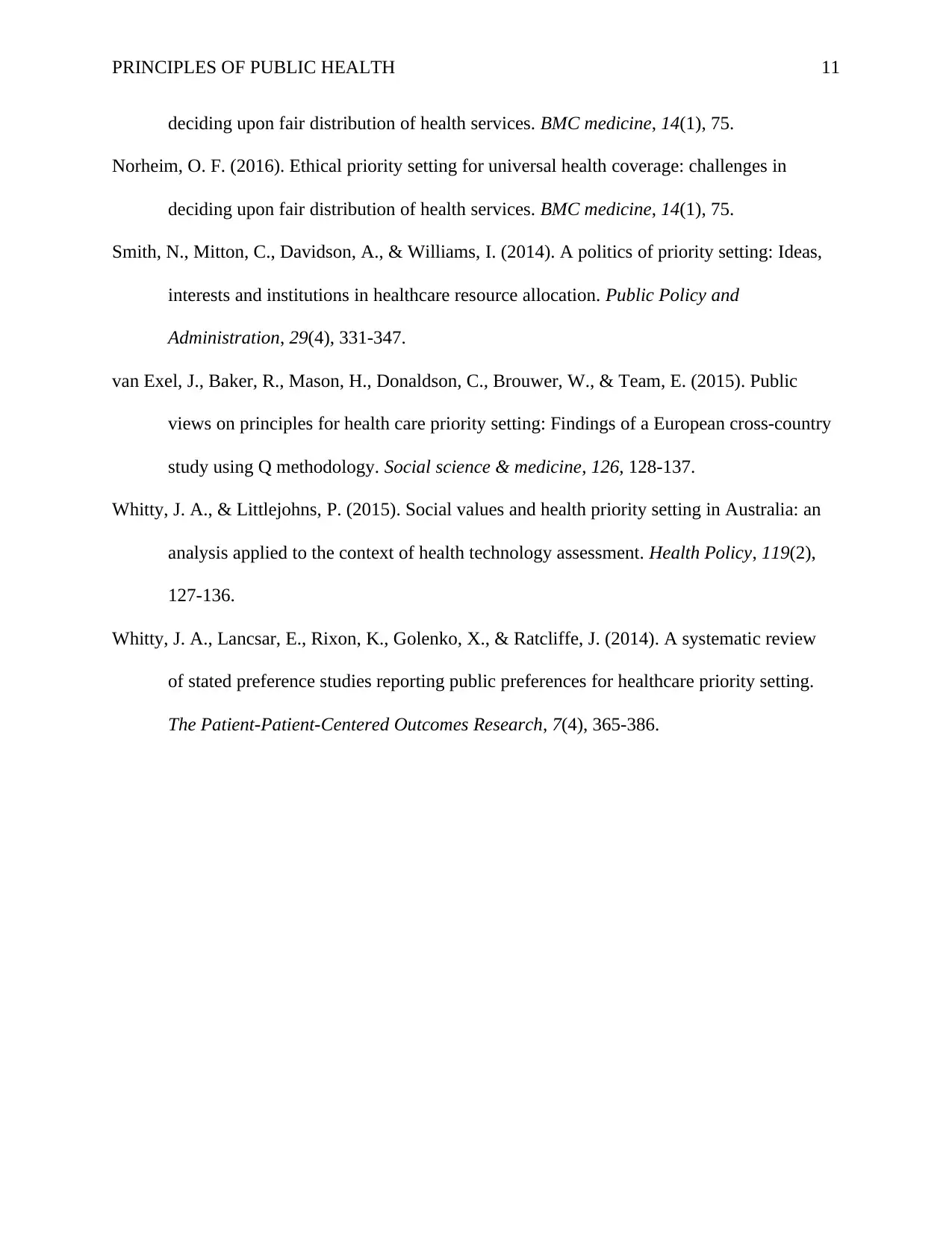
PRINCIPLES OF PUBLIC HEALTH 11
deciding upon fair distribution of health services. BMC medicine, 14(1), 75.
Norheim, O. F. (2016). Ethical priority setting for universal health coverage: challenges in
deciding upon fair distribution of health services. BMC medicine, 14(1), 75.
Smith, N., Mitton, C., Davidson, A., & Williams, I. (2014). A politics of priority setting: Ideas,
interests and institutions in healthcare resource allocation. Public Policy and
Administration, 29(4), 331-347.
van Exel, J., Baker, R., Mason, H., Donaldson, C., Brouwer, W., & Team, E. (2015). Public
views on principles for health care priority setting: Findings of a European cross-country
study using Q methodology. Social science & medicine, 126, 128-137.
Whitty, J. A., & Littlejohns, P. (2015). Social values and health priority setting in Australia: an
analysis applied to the context of health technology assessment. Health Policy, 119(2),
127-136.
Whitty, J. A., Lancsar, E., Rixon, K., Golenko, X., & Ratcliffe, J. (2014). A systematic review
of stated preference studies reporting public preferences for healthcare priority setting.
The Patient-Patient-Centered Outcomes Research, 7(4), 365-386.
deciding upon fair distribution of health services. BMC medicine, 14(1), 75.
Norheim, O. F. (2016). Ethical priority setting for universal health coverage: challenges in
deciding upon fair distribution of health services. BMC medicine, 14(1), 75.
Smith, N., Mitton, C., Davidson, A., & Williams, I. (2014). A politics of priority setting: Ideas,
interests and institutions in healthcare resource allocation. Public Policy and
Administration, 29(4), 331-347.
van Exel, J., Baker, R., Mason, H., Donaldson, C., Brouwer, W., & Team, E. (2015). Public
views on principles for health care priority setting: Findings of a European cross-country
study using Q methodology. Social science & medicine, 126, 128-137.
Whitty, J. A., & Littlejohns, P. (2015). Social values and health priority setting in Australia: an
analysis applied to the context of health technology assessment. Health Policy, 119(2),
127-136.
Whitty, J. A., Lancsar, E., Rixon, K., Golenko, X., & Ratcliffe, J. (2014). A systematic review
of stated preference studies reporting public preferences for healthcare priority setting.
The Patient-Patient-Centered Outcomes Research, 7(4), 365-386.
1 out of 11
Related Documents
Your All-in-One AI-Powered Toolkit for Academic Success.
+13062052269
info@desklib.com
Available 24*7 on WhatsApp / Email
![[object Object]](/_next/static/media/star-bottom.7253800d.svg)
Unlock your academic potential
Copyright © 2020–2025 A2Z Services. All Rights Reserved. Developed and managed by ZUCOL.





